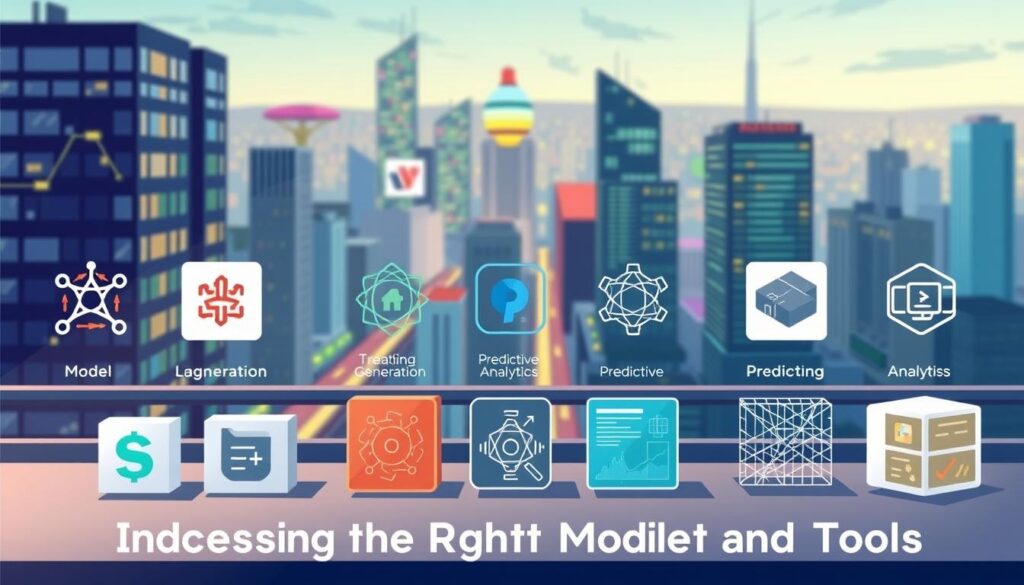Building a platform that delivers exclusive offers requires a blend of advanced AI models and user-centric design. By integrating powerful tools like Google AI Studio, you can create a seamless experience for your users. This approach ensures that your platform stands out in a competitive market.
Understanding pricing policies and free-tier usage is crucial. For instance, Google AI Studio offers free access, making it an excellent starting point for developers. This allows you to experiment with AI models without significant upfront costs.
Robust content management is another key factor. The text and user data you collect will drive the success of your platform. By leveraging AI, you can personalize offers and improve user engagement. This sets the foundation for a cost-efficient and scalable solution.
This guide will walk you through the technical and business aspects of building such a platform. You’ll gain insights into creating a system that meets user needs while staying ahead in the market.
Overview of AI-Powered Local Deals and Discounts
AI is transforming how users discover and access personalized offers in their area. By leveraging advanced models like Gemini 2.0 Flash, businesses can deliver tailored discounts that meet individual preferences. This shift not only enhances user experience but also drives engagement and loyalty.
Introduction to AI in the Local Deals Space
AI plays a crucial role in revolutionizing the way local deals are curated. Traditional methods often rely on broad demographics, but AI uses detailed user profiles to create personalized offers. For example, real-time data processing allows platforms to adjust discounts based on factors like inventory levels or user behavior.
This dynamic approach ensures that users receive relevant deals, improving their overall experience. Additionally, AI-powered search mechanisms make it easier to find offers that match specific needs, saving time and effort.
Benefits of Curated Discounts for Users
Curated discounts provide significant advantages for both users and businesses. For users, AI-driven recommendations offer streamlined service, ensuring they only see offers that matter to them. This level of personalization increases satisfaction and encourages repeat engagement.
For businesses, AI enables hyper-targeted campaigns that maximize ROI. By analyzing market demand patterns and competitor pricing, platforms can adjust strategies to stay competitive. This continuous change in technology ensures that businesses remain ahead in a fast-paced market.
Ultimately, AI-powered local deals create a win-win scenario. Users enjoy tailored discounts, while businesses benefit from increased efficiency and customer loyalty.
Create an AI-Powered App for Curated Local Deals and Discounts
AI-driven platforms bring precision and efficiency to the world of local discounts. By leveraging tailored input data, these systems ensure that users receive offers that match their preferences. This approach not only enhances user satisfaction but also drives engagement and loyalty.
Secure access to resources is another critical factor. Platforms that integrate advanced AI models, like the Gemini Developer API, can process diverse datum feeds efficiently. This capability allows for real-time adjustments, ensuring that offers remain relevant and competitive.
The purpose of integrating robust search mechanisms is to deliver context-specific offers. For example, AI can analyze user behavior and inventory levels to adjust discounts dynamically. This level of personalization sets your platform apart in a crowded market.
Aligning technical resources with business goals is essential. Real-world examples show how platforms that prioritize capability and scalability achieve long-term success. By processing and integrating diverse data safely, your application becomes a trusted resource for users and businesses alike.
Planning and Strategy for Your AI App
Effective planning is the backbone of any successful AI-driven platform. To ensure your solution stands out, you need a clear strategy that aligns with market needs and user expectations. This section will guide you through the essential steps to build a robust foundation for your project.
Understanding Your Target Market
Identifying your audience is the first thing to focus on. Start by creating a detailed list of user demographics, preferences, and pain points. This data will help you tailor your platform to meet specific needs.
For example, 75% of users prefer apps that offer personalized experiences. By leveraging natural language processing, you can refine communication and ensure your app resonates with its audience. This approach not only improves engagement but also builds trust.
Defining Clear App Objectives
Setting clear goals is crucial for guiding development decisions. Begin by outlining the key terms and features your app will offer. This list will serve as a roadmap, ensuring every aspect of your platform aligns with its purpose.
Additionally, use natural language techniques to make your app more intuitive. This ensures users can navigate your platform effortlessly, enhancing their overall experience. Real-world examples show that apps with well-defined objectives achieve higher success rates.
By combining market insights with strategic planning, you can create a platform that delivers value and stands out in a competitive landscape. Focus on aligning your app’s capabilities with user needs to ensure long-term success.
Choosing the Right AI Model and Tools
Selecting the right AI model is critical for delivering tailored experiences in any platform. The choice between open-source and commercial options depends on your technical needs and budget. This section will help you compare these tools to make an informed decision.

Comparing Open Source and Commercial Options
Open-source tools like Hugging Face offer flexibility and cost efficiency. They are ideal for developers who want to experiment without significant upfront costs. However, they may require more technical expertise to implement.
Commercial APIs, such as Google Gemini, provide advanced features and robust support. These tools are designed for scalability and ease of use, making them suitable for businesses with complex needs. Pricing models vary, so it’s essential to evaluate your budget.
When comparing these options, consider the language of their documentation. Clear and detailed guides can save time during implementation. Additionally, assess the detail of their feature sets to ensure they align with your platform’s goals.
For example, Hugging Face’s open-source libraries are highly customizable, while Gemini’s commercial APIs offer real-time processing capabilities. Both have unique strengths, so your choice should balance cost and functionality.
Ultimately, the right AI model will depend on your specific requirements. By analyzing the details of each option, you can select a tool that enhances your platform’s performance and user experience.
Data Curation and Memory Management for Personalization
Effective data curation is the backbone of personalized user experiences. By organizing and managing data efficiently, you can ensure your platform delivers tailored results. This process involves selecting reliable sources, implementing advanced search methods, and prioritizing user privacy.
Selecting Your Data Sources
Choosing the right data sources is crucial for fueling AI insights. Reliable sources ensure your platform can deliver accurate and relevant product recommendations. For example, integrating data from trusted APIs or cloud-based services can enhance the quality of your insights.
Real-world platforms like Milvus and Weaviate illustrate how diverse data feeds can improve personalization. These tools allow you to process dynamic content efficiently, ensuring your platform stays competitive.
Implementing Vector-Based Searches
Vector-based searches are essential for matching user queries with curated content. By using libraries like FAISS, you can implement code that enhances search accuracy. This method ensures users find offers that align with their preferences.
For instance, platforms leveraging vector databases can process large volumes of data in real time. This capability is critical for delivering context-specific results and improving user satisfaction.
Ensuring Data Privacy and Security
Protecting user data is a top priority in any cloud-based platform. Implementing robust security measures ensures privacy while managing large datasets. Tools like SingleStore offer hybrid search capabilities, making them ideal for secure data management.
By adhering to best practices, you can build trust with your users. This includes encrypting data, limiting access, and regularly auditing your systems. Real-world examples show how platforms that prioritize privacy achieve long-term success.
Integrating AI with Local Deals and Discounts Workflows
Integrating AI into local workflows requires a strategic blend of technology and user focus. To deliver tailored experiences, you need a robust architecture that seamlessly connects AI APIs and databases. This ensures your platform can process data efficiently while maintaining security.
Architectural Best Practices
Start by designing a scalable backend that supports real-time data processing. This allows your platform to adapt dynamically to user behavior. For example, using vector databases ensures quick and accurate searches for customer queries.
Next, implement feedback loops for sentiment analysis. These loops help refine recommendations based on user interactions. By analyzing feedback, you can continuously improve the relevance of offers.
Ensure your architecture prioritizes data security. Use encryption and access controls to protect sensitive information. This builds trust with users and safeguards your platform’s integrity.
Finally, focus on creating personalized workflows. AI-driven insights enable you to tailor offers to individual preferences. This level of customization enhances user satisfaction and drives engagement.
By following these best practices, you can build a platform that delivers value to both users and businesses. A well-designed architecture ensures efficiency, security, and scalability, setting your solution apart in a competitive market.
Enhancing User Experience with Personalized Offers
Tailoring interfaces to local preferences boosts engagement and satisfaction. By leveraging AI-driven tools, you can create designs that resonate with your audience. This approach ensures users feel valued and understood, driving long-term loyalty.
Customizing User Interfaces for Local Appeal
Customization starts with understanding your audience’s unique needs. AI-powered vision systems analyze user behavior to refine layouts and content. For example, leading library tools like NotebookLM help design interfaces that feel intuitive and familiar.
Machine learning techniques process user datum to dynamically adjust offers. This ensures that every interaction feels personal and relevant. Real-world examples show how platforms using these methods achieve higher engagement rates.
From a business perspective, tailored interfaces lead to better ROI. Users are more likely to engage with offers that match their preferences. This creates a win-win scenario for both users and businesses.
By focusing on local appeal, you can build a platform that stands out. Use AI to refine your designs and deliver experiences that users love.
Leveraging AI Platforms and Free Tools
AI platforms and free tools are revolutionizing how developers build and scale applications. These resources provide a cost-effective way to experiment, innovate, and deliver high-quality solutions. Whether you’re prototyping or deploying, leveraging these tools can save time and resources.

Overview of Google AI Studio and Gemini Models
Google AI Studio is a powerful platform that offers free access to advanced AI models. It’s ideal for rapid prototyping and testing. With tools like Gemini, you can integrate low-latency AI capabilities into your workflows. This ensures real-time processing, measured in minutes, for tasks like voice recognition and dynamic content adjustments.
Gemini models are designed for scalability and efficiency. They allow you to process large datasets quickly, making them perfect for applications that require speed and accuracy. By using these tools, you can enhance your platform’s performance without significant upfront costs.
Exploring Open Source Options like Hugging Face
Open-source platforms like Hugging Face provide flexibility and customization. They are excellent for developers who want to experiment with AI models without financial constraints. Hugging Face offers a wide range of pre-trained models, making it easier to integrate AI into your projects.
You can run virtual machine instances to support these models, ensuring smooth operations. Additionally, Hugging Face’s extensive documentation serves as a reliable source for troubleshooting and learning. This makes it a popular choice for developers worldwide.
By combining proprietary and open-source tools, you can create a robust AI infrastructure. This approach ensures flexibility, scalability, and cost-efficiency, setting your platform apart in a competitive market.
Implementing Pricing, Monetization, and Scalability
Monetizing AI-driven platforms requires a strategic blend of pricing models and user-focused strategies. To ensure profitability, you need to explore options like commission-based, subscription, and dynamic pricing. Each model offers unique advantages, and choosing the right one depends on your platform’s goals and target audience.
Commission-based models are popular in travel and deals apps. Platforms like Booking.com earn revenue by taking a percentage of each transaction. This option works well when your platform facilitates high-volume sales. It’s a proven way to generate consistent income while keeping upfront costs low for users.
Subscription models, on the other hand, provide recurring revenue. By offering premium features under a specific label, you can attract users willing to pay for enhanced services. For example, Kayak’s subscription plans include exclusive deals and priority support, improving the overall user experience.
Dynamic pricing adjusts offers in real time based on datum like demand and user behavior. This strategy maximizes revenue while ensuring competitiveness. AI-driven insights enable you to fine-tune pricing, creating a win-win scenario for both users and businesses.
Scalability is another critical factor. As your platform grows, you must ensure it can handle increased traffic and transactions. Leveraging datum for real-time adjustments and optimizing your infrastructure ensures sustainable growth. By focusing on scalability, you can meet market demands without compromising the user experience.
Real-world examples like Booking.com and Kayak demonstrate how effective monetization strategies can drive success. By combining data-driven decisions with scalable solutions, you can build a platform that thrives in a competitive market.
Best Practices and Real World Examples
Learning from real-world implementations can significantly enhance your AI-driven platform. By studying successful case studies, you can refine your approach and adopt proven methodologies. This section explores how businesses have leveraged AI to deliver personalized solutions effectively.
Case Studies and Success Stories
One notable example is Best Buy’s generative AI-powered virtual assistant. This tool troubleshoots product issues and manages subscriptions, improving the user experience. By analyzing customer interactions, the assistant provides tailored solutions, increasing satisfaction and loyalty.
Another success story comes from Carrefour Taiwan. Their AI Sommelier uses a vast database to offer personalized wine recommendations. This prompt-driven approach ensures users receive relevant suggestions, enhancing their shopping experience.
Dunelm’s AI-driven product discovery solution is another excellent example. It reduces search friction by analyzing user behavior and inventory levels. This approach ensures that users find what they need quickly, improving engagement and sales.
These case studies highlight the importance of using datum effectively. By integrating AI insights, businesses can deliver personalized offers that resonate with their audience. This strategy not only boosts user satisfaction but also drives long-term success.
Real-world examples like these demonstrate the power of combining technical best practices with user-focused strategies. By adopting these methods, you can create a platform that stands out in a competitive market.
Conclusion
The future of personalized offers lies in harnessing AI’s potential to transform user experiences. Throughout this guide, you’ve explored how innovative tools and accurate datum management can elevate your platform. By integrating AI, you can deliver tailored solutions that meet user needs and drive engagement.
Now is the time to take action. Leverage free platforms like Google AI Studio and Hugging Face to start building your solution. These resources provide a cost-effective way to experiment and scale your project efficiently.
Over time, AI integration can revolutionize your platform’s scalability and user experience. By focusing on personalization and leveraging the right tools, you can stay ahead in a competitive market. Start today, and transform your vision into a reality that delivers value to users and businesses alike.
